As we introduce you to the world of Haworthia attenuata, it’s our pleasure to share essential succulent care tips that will transform even a beginner into a confident caregiver for these enchanting plants. Known for their resilience and striking appearance, succulent plants like the Zebra Haworthia are a top choice among house plants, particularly for those new to the green-thumbed community. We understand the unique allure of bringing a new succulent plant into your living space; it’s not just about adding a bit of nature’s artistry—it’s also about the joy of nurturing life. Join us as we explore the simplicity yet intricacy of indoor plant care, tailored for those embarking on the gratifying path of beginner succulent care.
Key Takeaways
- Discover the essentials of nurturing Haworthia attenuata, an ideal plant for beginners.
- Learn the significance of choosing the proper environment and tools for successful succulent care.
- Develop an understanding of plant care basics to keep your succulents thriving.
- Gain insights into the most suitable conditions for these unique house plants.
- Embrace tips for beginner succulent care that simplify upkeep and promote health.
- Explore how the right balance of light, water, and soil contributes to the vitality of your new succulent plant.
- Engage with an approach that ensures your indoor plant care routine is both effective and joyous.
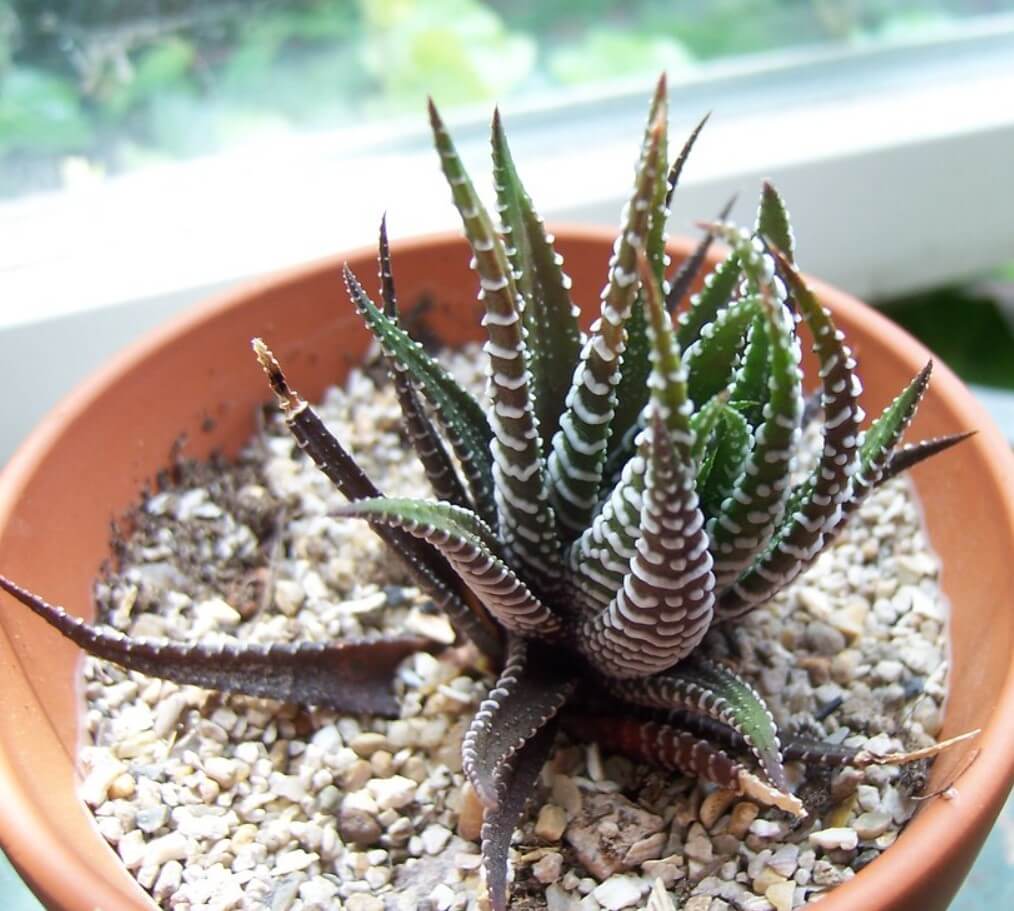
Understanding Your Haworthia Attenuata
As we delve into the intricacies of the Haworthia attenuata, commonly referred to as the Zebra Haworthia or Zebra Plant, it’s essential to familiarize ourselves with this succulent’s unique attributes. This South African native thrives under conditions that mimic its natural semi-arid environments, bringing a piece of exotic landscape to our homes.
Origins and Characteristics
The rosette-forming Haworthia attenuata hails from the Eastern Cape Province of South Africa. As a member of the diverse Aloeae tribe, this species is well-adapted to thrive in the arid conditions it originates from. Its popularity stems not only from its resilient nature but also from the aesthetic appeal of its plump, green leaves adorned with white tubercles.
Identifying the Zebra Plant
The Zebra Plant earns its moniker from the characteristic stripe-like tubercles that decorate its leaves. These white growths, reminiscent of a zebra’s stripes, give the plant a textured and visually appealing aspect, setting it apart from other succulent types. It’s a compact beauty that fits perfectly into a variety of interior settings, offering a touch of the wild to even the most urban of environments.
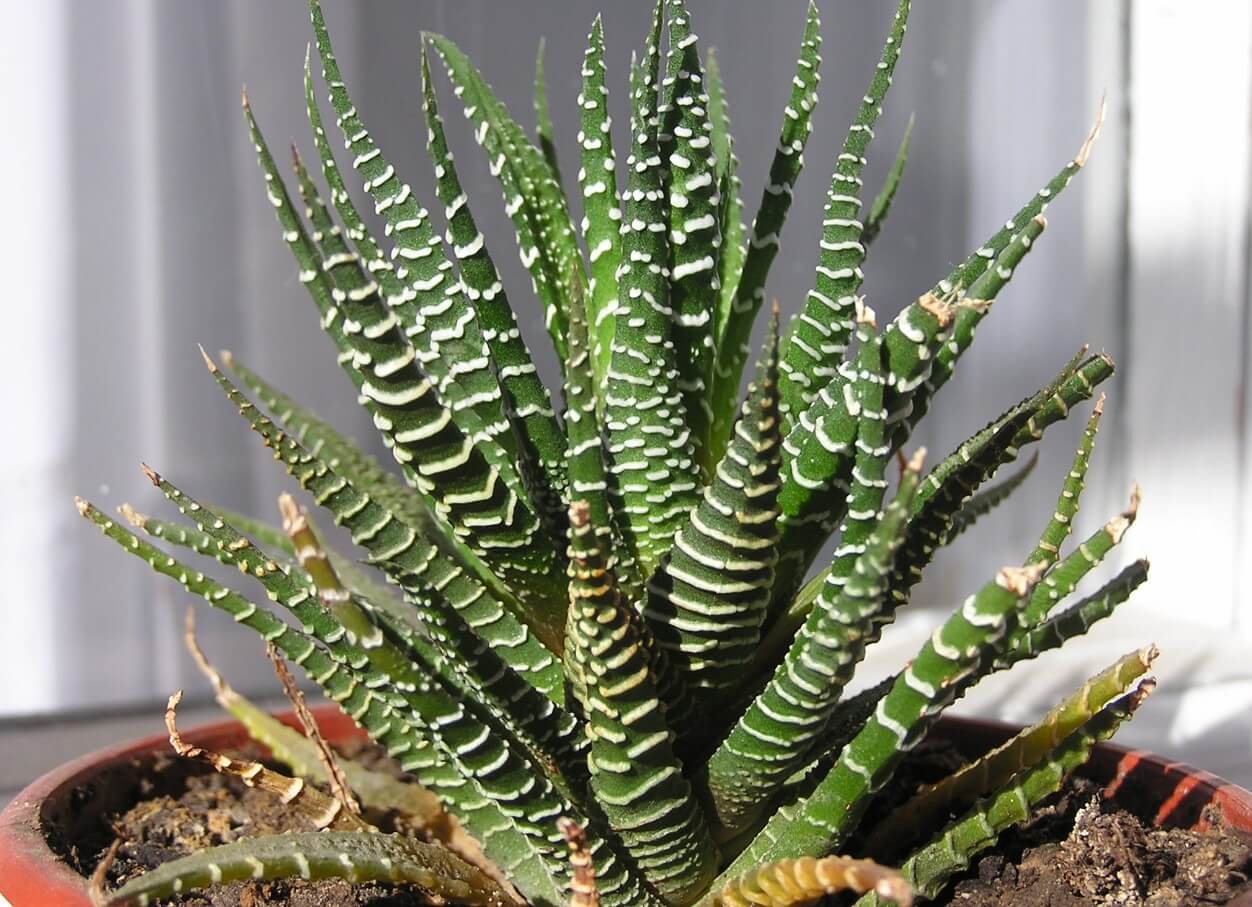
Haworthia Attenuata vs Haworthiopsis Fasciata
Recognizing the difference between Haworthia attenuata and its close relative, Haworthiopsis fasciata (formerly known as Haworthia fasciata), can be a challenge due to their similar appearance. However, the species have distinctive features when you take a closer look. One of the key differences is the location of the tubercles; in Haworthiopsis attenuata, they’re present on both sides of the leaves, while in Haworthiopsis fasciata, they appear only on the underside.
| Characteristic | Haworthia Attenuata | Haworthiopsis Fasciata |
|---|---|---|
| Native Region | Eastern Cape Province, South Africa | South Africa |
| Leaf Tubercles | Pronounced on both sides | Present only on the underside |
| Common Name | Zebra Haworthia | Zebra Plant |
| Leaf Texture | Textured with white bumps | Smooth with fewer white bumps |
By familiarizing ourselves with the Haworthia attenuata, we can better understand how to care for this enchanting succulent type, ensuring it thrives in our care.
The Ideal Soil Mixture for Haworthia Attenuata
We understand the importance of creating the perfect environment for our Haworthia attenuata, and it all begins with the soil mix. To foster a thriving growing condition that closely resembles the plant’s natural habitat, getting the soil mix right is non-negotiable. An effective soil mix must provide not only nutrients but also critical drainage to keep our succulent’s roots healthy.
A well-balanced blend allows us to avoid the dreaded waterlogged conditions that can instigate root rot—a common succulent killer. Our recommended recipe for success is a mixture of potting soil paired with elements like perlite or coarse sand. These gritty materials are champions at enhancing soil drainage and aeration.
| Component | Benefit | Volume Ratio |
|---|---|---|
| Potting Soil | Provides essential nutrients and moisture retention | 60% |
| Perlite | Improves aeration and water flow | 20% |
| Coarse Sand or Gritty Mix | Ensures added drainage and simulates a natural succulent environment | 20% |
When potting, selecting the right container or pot is just as crucial as the soil. Make sure your chosen container comes with adequate drainage holes that allow excess water to escape rather than accumulating at the root level. For those with a garden, planting your Haworthia attenuata in a patch designed for drainage, such as a raised bed or a naturally sandy soil area, is an added insurance against moisture buildup. Together, this recipe and container selection will provide a cozy abode for your succulents to prosper.
Incorporating this specific soil mixture into our garden care or indoor container setups guarantees that our varied sorts of succulent types, including the distinguished Haworthia attenuata, are set up for success. This foundation does not merely aid growth—it builds a fortress against common issues, cultivating plants that are as resilient as they are beautiful.
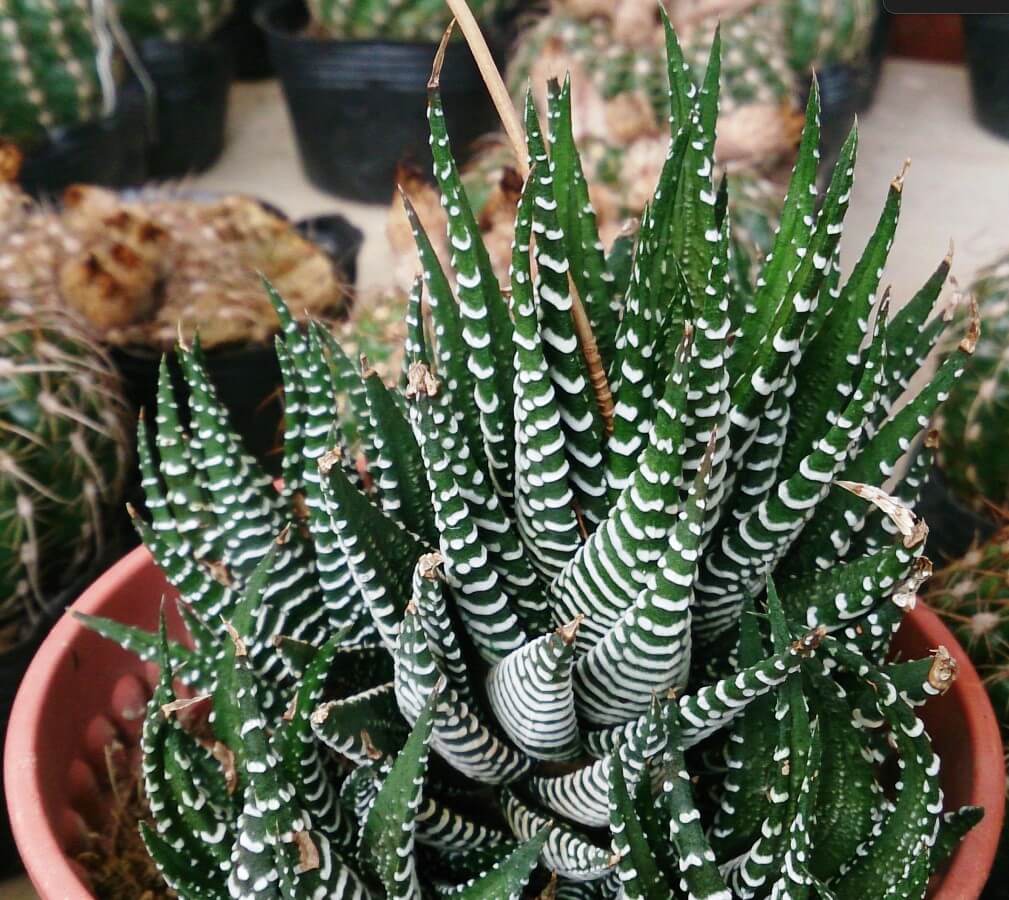
Proper Lighting and Sunlight Exposure for Robust Growth
As we focus on caring for our Haworthia attenuata, understanding the nuances of light, from the delicate rays of indirect light to the intensity of direct sunlight, is vital to ensure the plant’s growth and preserve its unique appearance. There must be a harmony between light sources to avoid sunlight damage while still providing an environment where our succulent plants can flourish.
Finding the Sweet Spot for Sunlight
We’ve found that the key to a healthy Haworthia attenuata lies in striking a balance in sunlight exposure. These succulents adore areas that provide bright light but do not take well to the fierce midday full sun. This is where positioning plays an integral role. Placing your plant in a spot that receives sunlight during the milder parts of the day could be the sweet spot you’re looking for, propelling your attenuata to vibrant health.
Navigating Seasonal Changes in Light
As the seasons transition, we adjust our approach to maximize the benefits that each brings. The length and intensity of daylight shift through the year, necessitating a keen eye to ensure that our succulent plants get enough light without exposure to the risks of seasonal changes. In the short days of winter, artificial grow lights might become indispensable allies in sustaining consistent growth.
Safeguarding Against Direct Sunlight Damage
Sunlight damage can be a real concern for Haworthia owners, especially with the intense summer sun. We must always be vigilant about too much direct sunlight, which can lead to unsightly sunburn on the leaves. Finding naturally filtered light, or using sheer curtains as a barrier, can provide ample protection while still ensuring your plants benefit from full sun at less intense times.
- Bright Indirect Light: Aim to position your Haworthia attenuata in an area where bright light is diffused.
- Seasonal Adaptation: Remain flexible and adjust the location of your plant or use grow lights as necessary.
- Protection from Harsh Sunlight: Use shades or sheer curtains to protect your succulents during peak sunlight hours.
| Season | Sunlight Requirement | Recommendations |
|---|---|---|
| Spring/Summer | Early Morning and Late Afternoon Sun | Use sheer curtains during midday |
| Fall/Winter | Maximum Available Light | Add grow lights to compensate for shorter days |
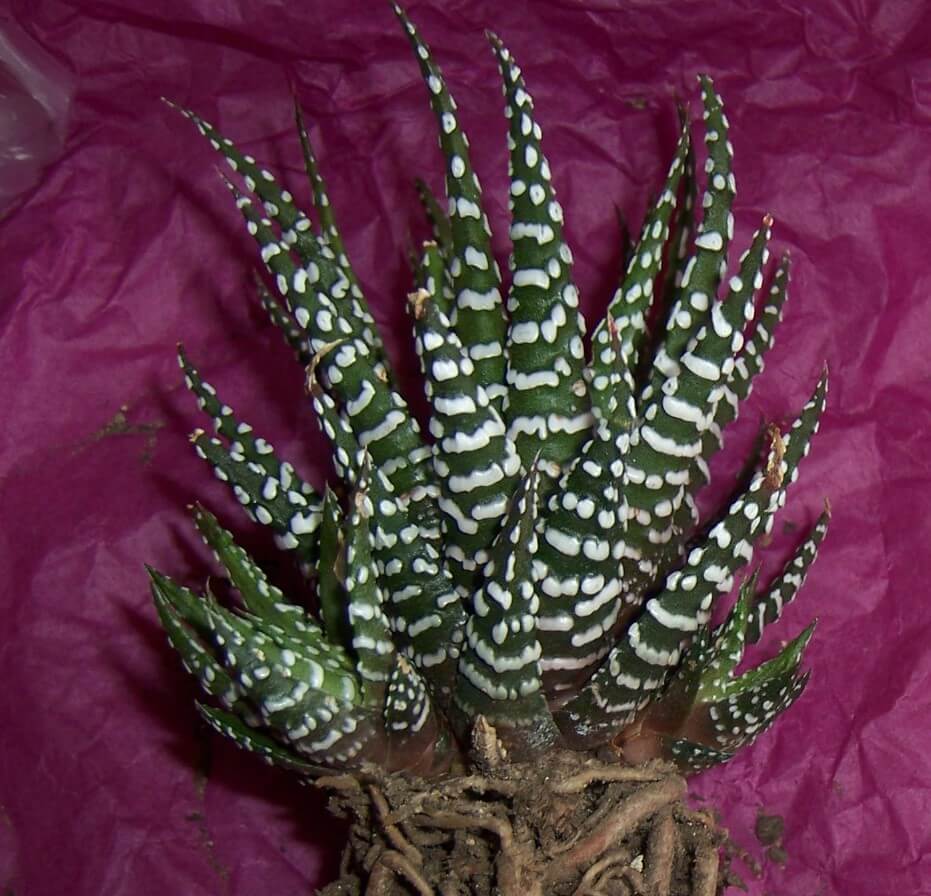
Watering Habits: Balancing Moisture and Drainage
When it comes to ensuring the health of our Zebra Haworthia, we understand the importance of a delicate balance in watering habits. As this succulent comes from a background where moisture is scarce, emulating a similar environment with our watering routine is key to mimicking its natural habitat. Let’s dive into deciphering the needs of this drought-tolerant plant.
Decoding the Thirst of Zebra Haworthia
While Zebra Haworthias are champions at surviving with minimal water, attention to their moisture needs should not be neglected. During their active growth in the warmth of summer, we wait for the soil in their pots or containers to dry completely before rehydrating. A deep watering technique ensures that every root gets a sip, promoting healthy growth without the risk of stagnation.
Seasonal Watering Patterns
As the seasons shift, so do our watering patterns. In summer, the warm weather nudges us to water them more frequently. But when winter arrives, we cut back on the water. Succulents like the Zebra Haworthia are adept at conserving water, making them less thirsty as the chill sets in.
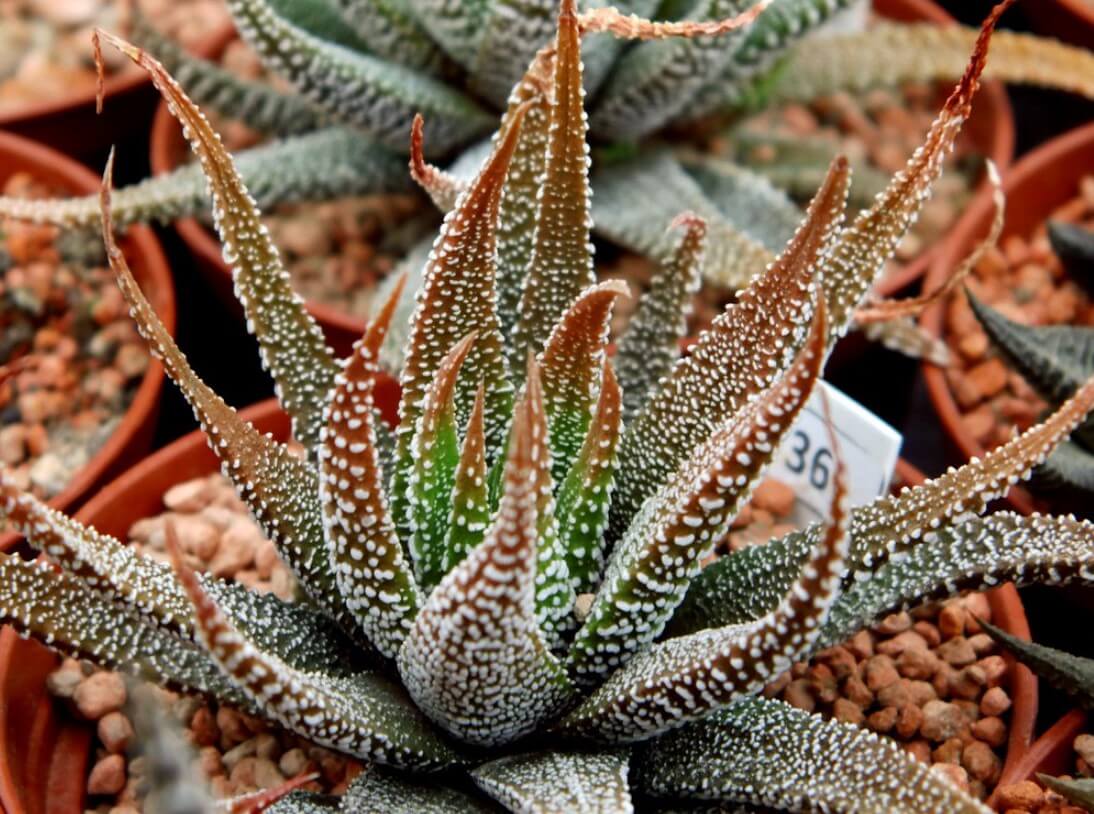
Signs of Overwatering and How to Correct It
Becoming familiar with the signs of overwatering is crucial for succulent care. When we spot soft or yellow leaves, or perhaps a mushy base, we know it’s time to intervene. At the first sign of too much moisture, the remedy is to simply let the soil dry out and reassess our watering habits — ensuring that our watering practices are in harmony with the needs of our Zebra Haworthia, regardless of the season.
| Season | Watering Frequency | Soil Condition Before Watering | Additional Tips |
|---|---|---|---|
| Summer | When soil is dry | Completely dry | Check more frequently due to higher evaporation rates |
| Winter | Less often | Mostly dry with slight moisture | Water less, as plants are dormant and growth is slow |
In our collective experience, adhering to these watering habits has enabled us to nurture our Zebra Haworthias to thrive. By giving water, the source of life, in appropriate measures and at the right time, we embody the balance between moisture and drainage that succulent care demands.
Propagation and Repotting: Growing Your Succulent Collection
As avid gardeners, we find propagation especially thrilling, offering a sustainable avenue to enhance our succulent collection. It begins with the offsets or ‘pups’ that the mother plant graciously produces. These tiny replicas of the main plant hold the promise of new life and can be coaxed gently from their parent using a sterile blade. With careful separation, each offset embarks on its own journey to become a thriving new plant.
When the time comes for repotting, it’s not merely about transferring roots to a new home. It’s about giving the plant a conducive environment for optimum growth. We always pick a pot that’s just a notch bigger than the previous one—giving roots room to grow without drowning them in soil. Our choice of soil mix is pivotal too; a well-draining concoction that’s kind to the delicate roots while fostering sturdy growth. Aligning our repotting schedule with the warmer months complements the plant’s natural active phase, ensuring a seamless transition.
- Propagation: A rewarding process to increase our succulent family.
- Offsets: The beginning of a new plant’s life, shared by its mother.
- Repotting: A crucial step to sustain the health and vitality of our green friends.
- Soil Mix: The foundation of a thriving succulent, providing nutrients and proper drainage.
| Stage | Process | Tools Needed | Care Tips |
|---|---|---|---|
| Propagation | Safely separating offsets from the mother plant | Clean, sharp knife | Gentle handling to avoid damaging tender roots |
| Post-Separation | Allowing cut areas to callous before planting | None | Place offsets in a warm, dry location for 1-2 days |
| Repotting | Planting offsets into individual pots | New pot with drainage, suitable soil mix | Ensure the pot size is proportional to the offset’s size |
| Growth Monitoring | Observing development and adjusting care | None | Keep the soil lightly moist and provide bright, indirect light |
Haworthia Attenuata Pests and Problems: Prevention and Solutions
Even the hardiest of houseplants like our own Haworthia attenuata can encounter pests and diseases that can threaten their health. We understand that prevention is better than cure, so we arm ourselves with the knowledge and interventions necessary to protect these succulent treasures. Below, we discuss some common threats and provide solutions to help you keep your succulents thriving.
Keeping Pests at Bay
Pests such as aphids and mealybugs can be a nuisance, but they are no match for vigilant care and early detection. Implementing a routine for regular plant inspection is key. Should you spot these unwanted visitors, we recommend using neem oil or insecticidal soap for effective pests control. Keep in mind that these invaders can cause damage to your plants by sucking the sap from the leaves, leading to weakened and damaged plants.
Tackling Common Diseases Affecting Succulents
Our succulents, despite their resilience, can fall victim to diseases like root rot and fungal infections. More often than not, these issues stem from overwatering. By adjusting our watering schedules and ensuring our pots have good drainage, we can often prevent such troubles. Prevention is really about understanding the care needs of Haworthia attenuata and acting accordingly to keep common diseases at bay.
First Aid for Damaged Zebra Plants
When problems surpass prevention, we’re ready to give our Zebra Plants the first aid they need. For plants affected by pests or disease, we take swift action by carefully removing any damaged or necrotic tissue, preventing further spread of the issue. This immediate response, coupled with corrective care adjustments, usually sets our succulents back on the path to recovery.
- To fend off aphids, we keep our plants strong and apply a soap-water solution when needed.
- Mealybugs may require a dab of alcohol on a cotton swab for direct application.
- Root rot’s best prevention is to let the soil dry out completely between waterings.
- With fungal infections, reducing humidity and improving air circulation can work wonders.
By staying attentive to the needs of our succulents and being proactive in the face of pests and problems, we can ensure the continued health and vigor of our beloved Haworthia attenuata.
Conclusion
As we reflect upon the care regimen for Haworthia attenuata, it is evident that the appeal of these indoor plants extends beyond their striking zebra stripes. The journey of nurturing a new plant, particularly a succulent like the Zebra Haworthia, can be a fulfilling adventure teeming with learning and delight. Equipped with the right succulent care tips, even those new to plant care can experience the joy of witnessing their garden thrive.
Final Thoughts on Haworthia Attenuata Care
Haworthia attenuata care is a testament to the harmony between beauty and resilience. By mastering the balance of sunlight, soil quality, and water requirements, growth is not only facilitated, but the natural elegance of these succulents is also magnified. And while we may occasionally grapple with pests, our proactive measures will safeguard the health of our zebra plants, ensuring their continued vigor.
Embracing the Journey with Your New Succulent Plant
Each moment spent caring for Haworthia attenuata marks a step further in a beginner-friendly voyage toward becoming a seasoned succulent enthusiast. As we embrace the nuances of plant care, we invite the serenity and beauty of nature into our lives. Our engagement with these small but mighty specimens of the garden world not only enhances our surroundings but also enriches our understanding of the delicate balance in the life of indoor plants.
FAQ
What type of soil is best for Haworthia attenuata?
The best soil for Haworthia attenuata is a well-draining soil mix. You can create this by amending regular potting soil with gritty materials like perlite or coarse sand to improve drainage and aeration. Make sure the pot also has drainage holes to prevent water from pooling around the roots, which can cause root rot.
How often should I water my Zebra Haworthia?
During the summer growing season, water your Zebra Haworthia when the soil has completely dried out. In the winter, decrease the frequency of watering to prevent excess moisture from accumulating and causing damage. Always check the soil moisture level before watering to avoid overwatering.
Does Haworthia attenuata need direct sunlight?
No, Haworthia attenuata does best in bright, indirect light. Direct sunlight, particularly in the intense midday, can lead to leaf burn. However, insufficient light can cause the plant to lose its vibrant patterns. They thrive when exposed to morning or late afternoon sun and may need extra lighting indoors during shorter winter days.
How do I propagate Haworthia attenuata?
To propagate Haworthia attenuata, look for offsets or “pups” produced by the mother plant. Gently separate the offsets from the main plant using a clean, sharp knife. Plant them in fresh, well-draining soil mix in a new pot, ideally during the warmer growth season, for the best chances of successful propagation.
How can I tell if my succulent is overwatered?
Signs of overwatering in succulents include soft, yellow or translucent leaves, a mushy base, and root rot. If you notice these symptoms, let the soil dry out thoroughly before resuming a more moderate watering schedule to allow your plant to recover.
What is the difference between Haworthia attenuata and Haworthiopsis fasciata?
Haworthia attenuata and Haworthiopsis fasciata are often confused due to their similar appearance. The main difference lies in the white tubercles; those of H. attenuata are present on both sides of its leaves and are more pronounced compared to H. fasciata, which has fewer tubercles and only on the underside of its leaves.
How do I deal with pests on my Haworthia attenuata?
To deal with pests like aphids and mealybugs on your Haworthia attenuata, it’s important to inspect your plants regularly. If pests are detected, you can use neem oil or insecticidal soap according to product directions to get rid of them. Good plant care practices and cleanliness can help prevent pest infestations.
When should I repot my Haworthia attenuata?
Repot your Haworthia attenuata when it outgrows its current container or every couple of years to refresh the soil. This is best done during the active growth period in the spring or summer. Choose a pot that’s just slightly larger than the current one with good drainage.
Can Haworthia attenuata be grown outdoors?
Yes, Haworthia attenuata can be grown outdoors in areas that don’t experience frost, as they are not cold hardy. They are suitable for growing in USDA Hardiness Zones 9 to 11. Make sure they are planted in a spot with well-draining soil and some protection from the intense afternoon sun.
How long can Haworthia attenuata live?
With proper care, Haworthia attenuata can live for many years. These succulents are slow growers, but given the right conditions of light, water, and soil, they can thrive and continually produce offsets for years to come.
